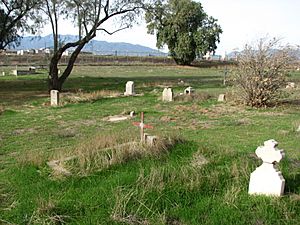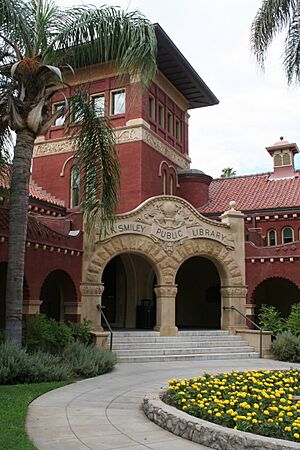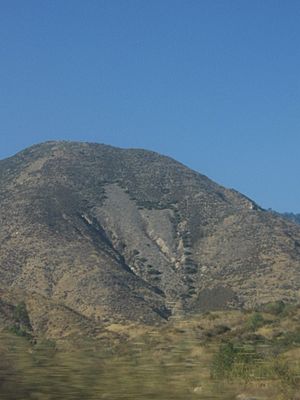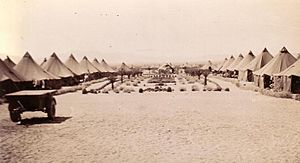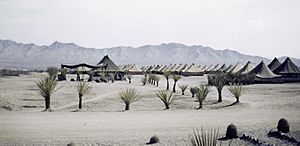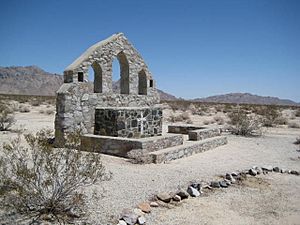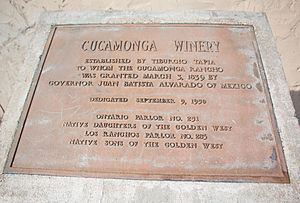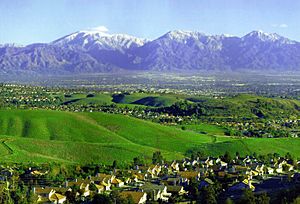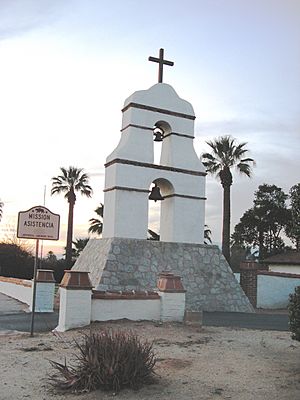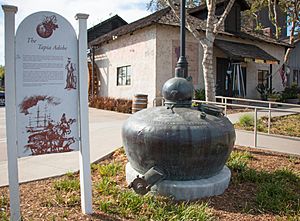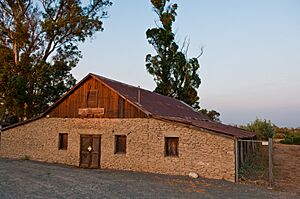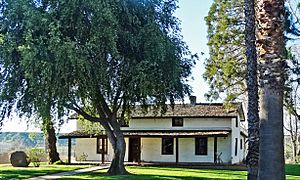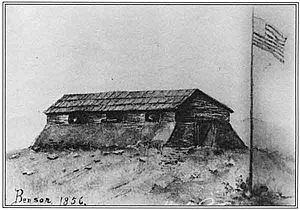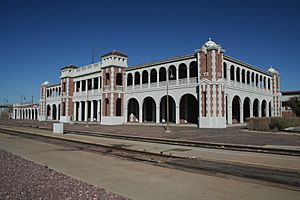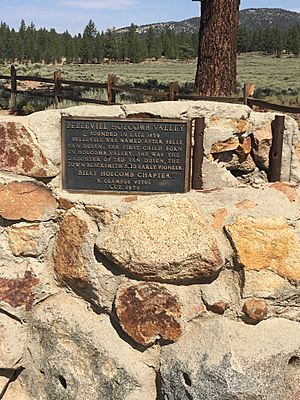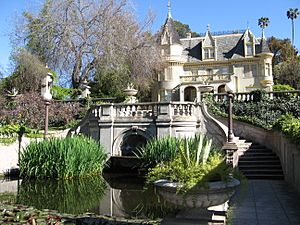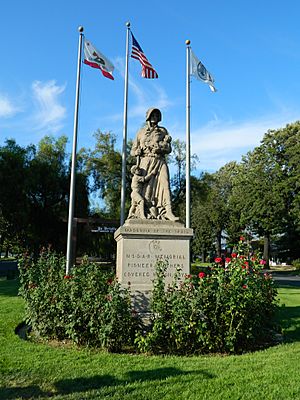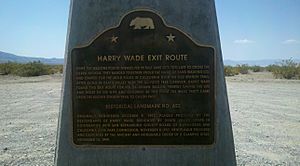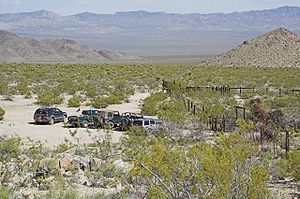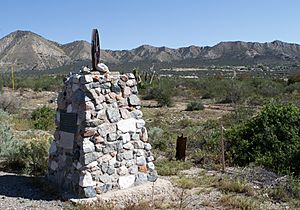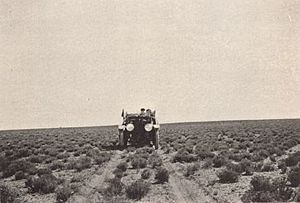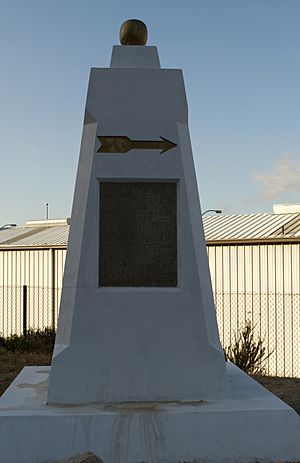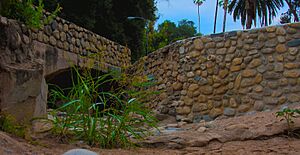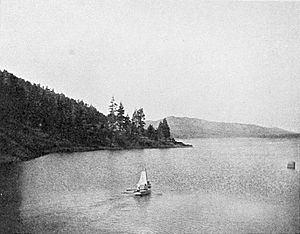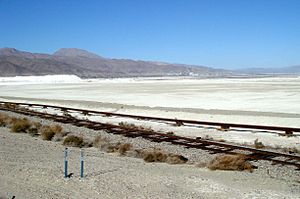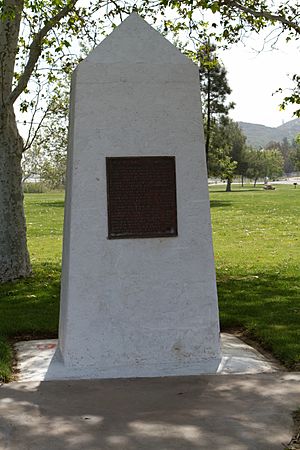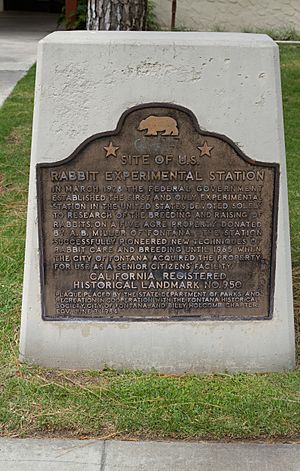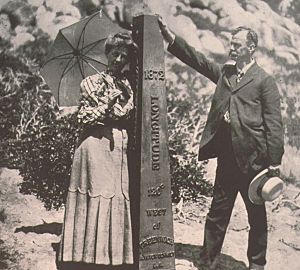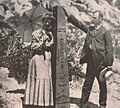California Historical Landmarks in San Bernardino County facts for kids
California is full of amazing places that tell stories about the past! In San Bernardino County, you can find many of these special spots. These places are called California Historical Landmarks. They are important because they help us remember the people, events, and buildings that shaped California's history. Think of them as historical treasures that teach us about how things used to be.
This list will take you on a journey through some of the most interesting historical landmarks in San Bernardino County. You'll learn about old towns, important roads, and unique buildings that have stood the test of time.
Contents
- Historic Places to Explore
- Agua Mansa Cemetery
- A.K. Smiley Public Library
- Arrowhead Springs
- Calico Ghost Town
- World War II Training Camps
- Chimney Rock
- Historic Ranches and Adobes
- Fort Benson
- Harvey House
- Holcomb Valley
- Kimberly Crest
- Madonna of the Trail
- Important Historical Roads and Trails
- Mill Creek Zanja
- Old Bear Valley Dam
- Searles Lake Borax Discovery
- Sycamore Grove
- U.S. Rabbit Experimental Station
- Von Schmidt State Boundary Monument
- Images for kids
Historic Places to Explore
Agua Mansa Cemetery
The Agua Mansa Cemetery is a very old burial ground. It was established in 1850 and is one of the oldest cemeteries in the region. Many early settlers of the San Bernardino Valley are buried here. It's a quiet place that reminds us of the pioneers who first lived in this area.
A.K. Smiley Public Library
The A.K. Smiley Public Library in Redlands is more than just a place to borrow books. It's a beautiful building that opened in 1898. It was named after Albert K. Smiley, who helped fund its construction. The library is known for its unique architecture and has been a center for learning and community for over a hundred years.
Arrowhead Springs
High in the mountains near San Bernardino, you'll find a natural landmark called Arrowhead. This giant, natural arrowhead shape on the mountainside has been a famous symbol for a long time. Native American tribes believed the springs here had healing powers. Later, it became a popular resort area.
Calico Ghost Town
Imagine a real ghost town! Calico is an old silver mining town near Yermo, California. It was founded in 1881 during California's silver rush. When silver lost its value, people left, and Calico became a ghost town. Today, it's a fun historical park where you can explore old buildings and learn about life in a mining town.
World War II Training Camps
During World War II, the deserts of San Bernardino County were used as a huge training ground for soldiers. These camps were part of the Desert Training Center.
These camps helped prepare American soldiers for fighting in the desert during the war. They are important reminders of the sacrifices made during that time.
Chimney Rock
Chimney Rock is a unique rock formation in Lucerne Valley. It's a natural landmark that has been a guidepost for travelers for many years. It stands tall and has seen countless journeys across the desert.
Historic Ranches and Adobes
San Bernardino County has many old ranches and adobe buildings that show how early settlers lived.
- Rancho Cucamonga: This area was once a large Mexican land grant. The Cucamonga Winery is part of this historic ranch.
- Rancho Santa Ana del Chino: Located in Chino, this was another important ranch that played a big role in the area's development.
- San Bernardino de Sena Estancia: In Redlands, this was an outpost of the San Gabriel Mission, used for farming and ranching.
- Tapia Adobe: Also in Rancho Cucamonga, this adobe house is one of the oldest buildings in the county.
- Yorba-Slaughter Adobe: This historic adobe in Chino was built in the 1850s and is a great example of early California architecture.
- Yucaipa Adobe: In Yucaipa, this adobe is one of the oldest standing buildings in the county, dating back to the 1840s.
Fort Benson
Fort Benson was a small fort built in 1856 near Colton. It was used to protect settlers during conflicts in the early days of the county. It reminds us of the challenges and dangers faced by those who first settled here.
Harvey House
The Harvey House in Barstow is a beautiful old building that served as a hotel and restaurant for travelers on the railroad. Built in 1911, it was a famous stop for people traveling across the country by train. It's a great example of early 20th-century travel and hospitality.
Holcomb Valley
Holcomb Valley near Big Bear City was the site of a major gold rush in the 1860s. Thousands of miners flocked to this remote valley hoping to strike it rich. It's a fascinating part of California's gold rush history, even though it's in the mountains, not the famous "Gold Country."
Kimberly Crest
Kimberly Crest is a stunning French-style mansion in Redlands. Built in 1897, it's known for its beautiful architecture and gardens. It offers a glimpse into the lives of wealthy families in California at the turn of the 20th century.
Madonna of the Trail
The Madonna of the Trail monument in Upland is a statue honoring the brave pioneer women who traveled across America. It's one of twelve such statues placed along the National Old Trails Road, marking the paths taken by early settlers.
Important Historical Roads and Trails
Many landmarks in San Bernardino County mark important old roads and trails that helped people travel and settle the West.
- Henry Wade Exit Route: This marks a difficult escape route used by a group of pioneers from Death Valley in 1850.
- Mojave Road: An ancient Native American trade route that later became a path for explorers and settlers crossing the desert.
- Mormon Lumber Road: This road was built by early Mormon settlers to transport timber from the mountains.
- Mormon Trail Monument: Marks a section of the trail used by Mormon pioneers to reach the San Bernardino Valley.
- National Old Trail Monument: This monument in Needles marks the historic National Old Trails Road, an early cross-country highway.
- Santa Fe And Salt Lake Trail Monument: Located in Cajon Pass, this monument marks where the Santa Fe Trail and the Salt Lake Trail met. These were major routes for pioneers heading West.
Mill Creek Zanja
The Mill Creek Zanja in Redlands is one of the oldest irrigation ditches in California. It was built in 1819 by Native Americans and missionaries to bring water from Mill Creek to farmlands. It's an amazing example of early engineering and how people managed water resources.
Old Bear Valley Dam
The Old Bear Valley Dam at Big Bear Lake is a very old dam, built in 1884. It was an important part of bringing water to the growing farmlands in the valley below. It's a cool example of early engineering in the mountains.
Searles Lake Borax Discovery
Searles Lake is a dry lakebed where borax was discovered in 1862. This discovery led to a major industry in the desert, as borax was used in many products. This landmark marks an important moment in California's mining history.
Sycamore Grove
Sycamore Grove in Devore is a historic spot that was a popular resting place for travelers on the old trails. It was a natural oasis with shade and water, offering a welcome break for pioneers and their animals.
U.S. Rabbit Experimental Station
The U.S. Rabbit Experimental Station in Fontana might sound unusual, but it was an important research center. From 1928 to 1954, scientists here studied rabbits to improve breeding and health for meat and fur production. It shows a unique part of agricultural history.
Von Schmidt State Boundary Monument
The Von Schmidt State Boundary Monument near Needles marks part of the border between California and Nevada. It was placed in 1872 by surveyor Alexey W. Von Schmidt to officially define the state line. It's a cool reminder of how state boundaries were created.
Images for kids


